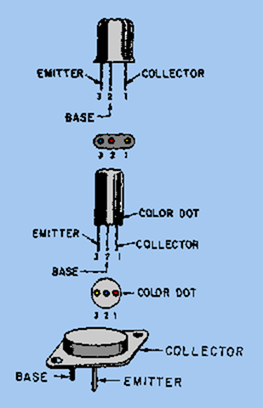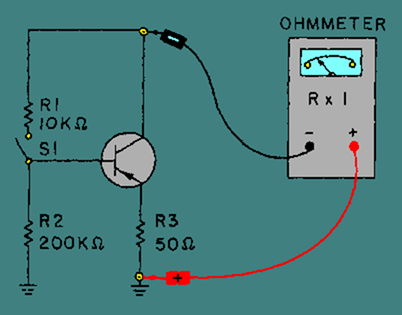MICROELECTRONICS
Up to now the various semiconductors, resistors, capacitors, etc., in our discussions have been considered as separately packaged components, called DISCRETE COMPONENTS. In this section we will introduce some of the more complex devices that contain complete circuits packaged as a single component. These devices are referred to as INTEGRATED CIRCUITS and the broad term used to describe the use of these devices to miniaturize electronic equipment is called MICROELECTRONICS.
With the advent of the transistor and the demand by the military for smaller equipment, design engineers set out to miniaturize electronic equipment. In the beginning, their efforts were frustrated because most of the other components in a circuit such as resistors, capacitors, and coils were larger than the transistor. Soon these other circuit components were miniaturized, thereby pushing ahead the development of smaller electronic equipment. Along with miniature resistors, capacitors, and other circuit elements, the production of components that were actually smaller than the space required for the interconnecting wiring and cabling became possible. The next step in the research process was to eliminate these bulky wiring components. This was accomplished with the PRINTED CIRCUIT BOARD (PCB).
A printed circuit board is a flat insulating surface upon which printed wiring and miniaturized components are connected in a predetermined design, and attached to a common base. Figure 2-20 (view A and view B) shows a typical printed circuit board. Notice that various components are connected to the board and the printed wiring is on the reverse side. With this technique, all interconnecting wiring in a piece of equipment, except for the highest power leads and cabling, is reduced to lines of conducting material (copper, silver, gold, etc.) deposited directly on the surface of an insulating "circuit board." Since printed circuit boards are readily adapted as plug-in units, the elimination of terminal boards, fittings and tie points, not to mention wires, results in a substantial reduction in the overall size of electronic equipment.
Figure 2-20A. – A typical printed circuit board (PCB). FRONT SIDE
 Figure 2-20B. – A typical printed circuit board (PCB). REVERSE SIDE
Figure 2-20B. – A typical printed circuit board (PCB). REVERSE SIDE
 After the printed circuit boards were perfected, efforts to miniaturize electronic equipment were then shifted to assembly techniques, which led to MODULAR CIRCUITRY. In this technique, printed circuit boards are stacked and connected together to form a module. This increases the packaging density of circuit components and results in a considerable reduction in the size of electronic equipment.
After the printed circuit boards were perfected, efforts to miniaturize electronic equipment were then shifted to assembly techniques, which led to MODULAR CIRCUITRY. In this technique, printed circuit boards are stacked and connected together to form a module. This increases the packaging density of circuit components and results in a considerable reduction in the size of electronic equipment.
Since the module can be designed to perform any electronic function, it is also a very versatile unit.
However, the drawback to this approach was that the modules required a considerable number of connections that took up too much space and increased costs. In addition, tests showed the reliability was adversely affected by the increase in the number of connections.
A new technique was required to improve reliability and further increase packaging density. The solution was INTEGRATED CIRCUITS.
An integrated circuit is a device that integrates (combines) both active components (transistors, diodes, etc.) and passive components (resistors, capacitors, etc.) of a complete electronic circuit in a single chip (a tiny slice or wafer of semiconductor crystal or insulator).
Integrated circuits (ICs) have almost eliminated the use of individual electronic components (resistors, capacitors, transistors, etc.) as the building blocks of electronic circuits. Instead, tiny CHIPS have been developed whose functions are not that of a single part, but of dozens of transistors, resistors, capacitors, and other electronic elements, all interconnected to perform the task of a complex circuit. Often these comprise a number of complete conventional circuit stages, such as a multistage amplifier (in one extremely small component). These chips are frequently mounted on a printed circuit board, as shown in figure 2-21, which plugs into an electronic unit.
Figure 2-21. – ICs on a printed circuit board.

Integrated circuits have several advantages over conventional wired circuits of discrete components. These advantages include (1) a drastic reduction in size and weight, (2) a large increase in reliability, (3) lower cost, and (4) possible improvement in circuit performance. However, integrated circuits are composed of parts so closely associated with one another that repair becomes almost impossible. In case of trouble, the entire circuit is replaced as a single component.
Basically, there are two general classifications of integrated circuits: HYBRID and MONOLITHIC. In the monolithic integrated circuit, all elements (resistors, transistors, etc.) associated with the circuit
are fabricated inseparably within a continuous piece of material (called the SUBSTRATE), usually silicon. The monolithic integrated circuit is made very much like a single transistor. While one part of the crystal is being doped to form a transistor, other parts of the crystal are being acted upon to form the associated resistors and capacitors. Thus, all the elements of the complete circuit are created in the crystal by the same processes and in the same time required to make a single transistor. This produces a considerable cost savings over the same circuit made with discrete components by lowering assembly costs.
Hybrid integrated circuits are constructed somewhat differently from the monolithic devices. The PASSIVE components (resistors, capacitors) are deposited onto a substrate (foundation) made of glass, ceramic, or other insulating material. Then the ACTIVE components (diodes, transistors) are attached to the substrate and connected to the passive circuit components on the substrate using very fine (.001 inch) wire. The term hybrid refers to the fact that different processes are used to form the passive and active components of the device.
Hybrid circuits are of two general types: (1) thin film and (2) thick film. "Thin" and "thick" film refer to the relative thickness of the deposited material used to form the resistors and other passive components. Thick film devices are capable of dissipating more power, but are somewhat more bulky.
Integrated circuits are being used in an ever increasing variety of applications. Small size and weight and high reliability make them ideally suited for use in airborne equipment, missile systems, computers, spacecraft, and portable equipment. They are often easily recognized because of the unusual packages that contain the integrated circuit. A typical packaging sequence is shown in figure 2-22. These tiny packages protect and help dissipate heat generated in the device. One of these packages may contain one or several stages, often having several hundred components. Some of the most common package styles are shown in figure 2-23.
Figure 2-22. – A typical integrated circuit packaging sequence.

Figure 2-23. – Common IC packaging styles.
 The preceding information was presented to give you a brief introduction into integrated circuits. If you wish to pursue this subject further, additional information is available in your ship’s or station’s library.
The preceding information was presented to give you a brief introduction into integrated circuits. If you wish to pursue this subject further, additional information is available in your ship’s or station’s library.
Back
Home
Up
Next
SUMMARY of TRANSISTORS
Now that you have completed this chapter, a short review of the more important points covered in the chapter will follow. This review should refresh your memory of transistors, their theory of operation, and how they are tested with an ohmmeter.
A TRANSISTOR is a three or more element solid-state device that amplifies by controlling the flow of current carriers through its semiconductor materials.
The THREE ELEMENTS OF A TRANSISTOR are (1) the EMITTER, which gives off current carriers, (2) the BASE, which controls the carriers, and (3) the COLLECTOR, which collects the carriers.

The two BASIC TYPES OF TRANSISTORS are the NPN and PNP. The only difference in symbology between the two transistors is the direction of the arrow on the emitter. If the arrow points in, it is a PNP transistor and if it points outward , it is an NPN transistor.
The four TRANSISTOR MANUFACTURING PROCESSES are the (1) point contact, (2) grown or rate-grown junction, (3) alloy or fused junction, and (4) diffused junction.

The PROPER BIASING OF A TRANSISTOR enables the transistor to be used as an amplifier. To function in this capacity, the emitter-to-base junction of the transistor is forward biased, while the base-to-collector junction is reverse biased.

NPN TRANSISTOR OPERATION is basically the action of a relatively small emitter-base bias voltage controlling a relatively large emitter-to-collector current.

PNP TRANSISTOR OPERATION is essentially the same as the NPN operation except the majority current carriers are holes and the bias batteries are reversed.

AMPLIFICATION is the process of increasing the strength of a signal.
An AMPLIFIER is the device that provides amplification without appreciably altering the original signal.
The BASIC TRANSISTOR AMPLIFIER amplifies by producing a large change in collector current for a small change in base current. This action results in voltage amplification because the load resistor placed in series with the collector reacts to these large changes in collector current which, in turn, results in large variations in the output voltage.
The three types of BIAS used to properly bias a transistor are base-current bias (fixed bias), self-bias, and combination bias.
Combination bias is the one most widely used because it improves circuit stability and at the same time overcomes some of the disadvantages of base-current bias and self-bias. 
THE CLASS OF AMPLIFIER OPERATION is determined by the portion of the input signal for which there is an output.
There are four classes of amplifier operations: class A, class AB, class B, and class C.
CUTOFF occurs when the base-to-emitter bias prevents current from flowing in the emitter circuit. For example, in the PNP transistor, if the base becomes positive with respect to the emitter, holes are repelled at the emitter-base junction. This prevents current from flowing in the collector circuit.
SATURATION occurs in a PNP transistor when the base becomes so negative, with respect to the emitter, that changes in the signal are not reflected in collector-current flow.
CLASS A AMPLIFIERS are biased so that variations in input signal polarities occur within the limits of cutoff and saturation. Biasing an amplifier in this manner allows collector current to flow during the complete cycle (360 degrees) of the input signal, thus providing an output which is a replica of the input but 180 degrees out of phase.
Class A operated amplifiers are used as audio- and radio-frequency amplifiers in radio, radar, and sound systems.

CLASS AB AMPLIFIERS are biased so that collector current is zero (cutoff) for a portion of one alternation of the input signal. Therefore, collector current will flow for more than 180 degrees but less than 360 degrees of the input signal. The class AB amplifier is commonly used as a push-pull amplifier to overcome a side effect of class B operations.
CLASS B AMPLIFIERS are biased so that collector current is cut off during one-half of the input signal. Thus, for a class B operation, collector current will flow for approximately 180 degrees (half) of the input signal.
The class B operated amplifier is used as an audio amplifier and sometimes as the driver- and power-amplifier stage of transmitters.

CLASS C AMPLIFIERS are biased so that collector current flows for less than one-half cycle of the input signal.
The class C operated amplifier is used as a radio-frequency amplifier in transmitters.

FIDELITY and EFFICIENCY are two terms used in conjunction with amplifiers. Fidelity is the faithful reproduction of a signal, while efficiency is the ratio of output signal power compared to the total input power.
The class A amplifier has the highest degree of fidelity, but the class C amplifier has the highest efficiency.
A TRANSISTOR CONFIGURATION is the particular way a transistor is connected in a circuit. A transistor may be connected in any one of three different configurations: common emitter (CE), common base (CB), and common collector (CC).
The COMMON-EMITTER CONFIGURATION (CE) is the most frequently used configuration in practical amplifier circuits, since it provides good voltage, current, and power gain. The input to the CE is applied to the base-emitter circuit and the output is taken from the collector-emitter circuit, making the emitter the element "common" to both input and output. The CE is set apart from the other configurations, because it is the only configuration that provides a phase reversal between input and output signals.

The COMMON-BASE CONFIGURATION (CB) is mainly used for impedance matching, since it has a low input resistance and a high output resistance. It also has a current gain of less than 1.
In the CB, the input is applied to the emitter, the output is taken from the collector, and the base is the element common to both input and output.

The COMMON-COLLECTOR CONFIGURATION (CC) is used as a current driver for impedance matching and is particularly useful in switching circuits. The CC is also referred to as an emitter-follower and is equivalent to the electron-tube cathode follower. Both have high input impedance and low output impedance.
In the CC, the input is applied to the base, the output is taken from the emitter, and the collector is the element common to both input and output.
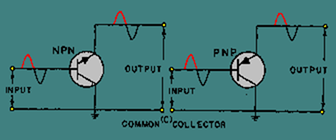
GAIN is a term used to describe the amplification capabilities of an amplifier. It is basically a ratio of output to input. The current gain for the three transistor configurations (CB, CE, and CC) are ALPHA (a), BETA (b), and GAMMA (g), respectively.

The TRANSISTOR CONFIGURATION COMPARISON CHART gives a rundown of the different properties of the three configurations.

TRANSISTOR CHARACTERISTICS are usually presented on specification sheets. These sheets usually cover the following items:
-
The kind of transistor.
-
The absolute maximum ratings of the transistor.
-
The typical operating values of the transistor.
-
Additional engineering/design information.
TRANSISTORS ARE IDENTIFIED by a Joint Army-Navy (JAN) designation printed directly on the case of the transistor. If in doubt about a transistor’s markings, always replace a transistor with one having identical markings, or consult an equipment or transistor manual to ensure that an identical replacement or substitute is used.
TESTING A TRANSISTOR to determine if it is good or bad can be done with an ohmmeter or transistor tester or by the substitution method.
PRECAUTIONS should be taken when working with transistors since they are susceptible to damage by electrical overloads, heat, humidity, and radiation.
plays an important part in transistor maintenance because before a transistor can be tested or replaced, its leads must be identified. Since there is NO standard method of identifying transistor leads, check some typical lead identification schemes or a transistor manual before attempting to replace a transistor.
A TRANSISTOR GAIN TEST can be made using an ohmmeter and a simple test circuit. The principle behind this test lies in the fact that little or no current will flow in a transistor between emitter and collector until the emitter-base junction is forward biased.
A 10-to-1 resistance ratio in the test between meter readings indicates normal gain.
TRANSISTOR JUNCTION RESISTANCE TEST can also be made using an ohmmeter by measuring the base-emitter, base-collector, and collector-emitter forward and reverse resistances.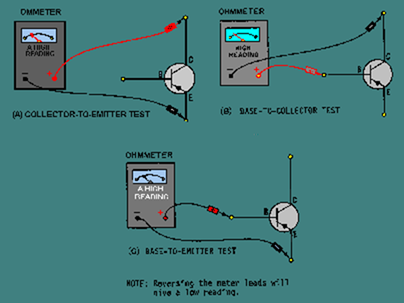
MICROELECTRONICS is a broad term used to describe the use of integrated circuits to miniaturize electronic equipment.
A PRINTED CIRCUIT BOARD (PCB) is a flat, insulating surface upon which printed wiring and miniaturized components are connected in a predetermined design and attached to a common base.
MODULAR CIRCUITRY is an assembly technique in which printed circuit boards are stacked and connected together to form a module. This technique increases the packaging density of circuit components and results in a considerable reduction in the size of electronic equipment.
An INTEGRATED CIRCUIT is a device that integrates (combines) both active components (transistors, diodes, etc.) and passive components (resistors, capacitors, etc.) of a complete electronic circuit in a single chip.
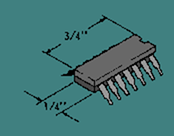
The two basic types of ICs are the HYBRID and the MONOLITHIC.
In the MONOLITHIC IC, all elements (resistors, transistors, etc.) associated with the circuit are fabricated inseparably with a continuous piece of material (called the substrate).
In the HYBRID IC, the passive components (resistors, capacitors) are deposited onto a substrate (foundation) made of glass, ceramic, or other insulating material. Then the active components (diodes, transistors) are attached to the substrate and connected to the passive components using fine wire.
Back
Home
Up
Next
ANSWERS TO QUESTIONS Q1. THROUGH Q42.
A1. Transistor
A2. Amplification.
A3. Outward.
A4. Point-contact.
A5. Quality control.
A6. Positive, more positive.
A7. Because the N material on one side of the forward-biased junction is more heavily doped than the P-material.
A8. The P or base section.
A9. 98 percent.
A10. Holes.
A11. The polarity of voltage applied to the PNP transistor is opposite of that applied to the NPN transistor
A12. I B.
A13. The base current loop and the collector current loop.
A14. Amplifier.
A15. Compensation for slight variations in transistor characteristics and changes in transistor conduction because of temperature variations.
A16. The signals are opposite in polarity or 180 degrees out of phase with each other.
A17. The polarity of the source voltage.
A18. Base current bias or fixed bias.
A19. Self-bias.
A20. When it is necessary to prevent amplitude distortion.
A21. The voltage-divider type.
A22. Class A.
A23. Cutoff.
A24. The amount of bias and the amplitude of the input signal.
A25. Class A.
A26. Common emitter (CE), common base (CB), and common collector (CC).
A27. Common emitter.
A28. Base current (I B).
A29. Alpha (a).
A30. Common base.
A31. IE.
A32. Common collector.
A33.![]()
A34. The kind of transistor, the transistor’s common applications, and mechanical data. A35. The number of junctions in the device, which in this case indicates a transistor.
A36. Heat.
A37. The substitution method.
A38. The power must be removed from the circuit.
A39. By the wide space between the collector lead and the other two leads (emitter and base).
A40. Gain and junction resistance.
A41. Normal gain.
A42. A leaking transistor
Back
Home
Up
Next







